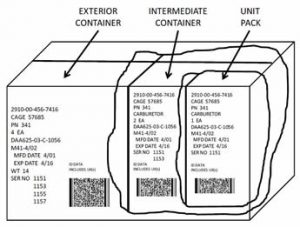Mil-Std-129 Revision R represents some major changes to the bar code label formats currently in use by defense contractors. The DOD’s transition to life cycle management of serialized items with item unique identification (IUID/UID) has driven many of these changes from Mil-Std-129P, Change 4, which Revision R has superseded.
There is an upside for defense contractors. Revision R eliminates the myriad linear bar codes that crowded labels under the previous MS-129P. The linear barcodes for NSN, CAGE, CLIN, contract, shipment and serial numbers (up to five) have been replaced by a single two-dimensional symbol (PDF417) in the revised standard.
By replacing the notoriously challenging requirement of printing up to ten linear bar codes with a single 2D-PDF417 symbol means that the exterior container format will now fit easily on a standard four-by-six inch label rather than requiring two such labels. This is particularly helpful when doing RFID labeling.
There are many significant of the changes in Mil-Std-129 Revision R, including:
- The 2D (PDF417) bar code is recommended for use in all packaging identification marking and some figures have been modified to remove the linear bar codes.
- Palletized unit loads are specifically called out for identification and bar code marking.
- The military shipping label (MSL) format includes a transportation tracking number (TTN) as a conditional data element for systems than can generate and encode it.
- The PDF417 bar code content for unit pack and container marking was modified to include data qualifiers for the part number (DI ‘1P’) and for the quantity and unit of issue (DI ‘7Q’).
- The ammunition and explosives section (see 5.14) is completely rewritten to include a new ammunition/explosive packaging label. Most of the existing paragraphs are revised; however, a large portion of the text is moved to different paragraphs and not changed.
- For other than assorted item packs, serial number / UII number lists are required when more than five serialized items are included in a container.
The use of the 2D (PDF417) bar code in place of linear barcodes greatly simplifies label formatting.
However, it is important that the PDF417 is generated according to the rigorous data structuring requirements specified in Table IV of the specification.
Once that challenge is overcome with appropriate software, defense contractors generating military standard labels for shipment into the supply chain their job easier.
The good news for Mil-Pac users is that its MIL-Comply software for Mil-Std-129R labels already supports the use of the PDF417 symbols, as they were first introduced in Revision P, Change 4. The effect of Revision R is to expand Mil-Std-129 use of the 2D symbol formats in place of linear bar codes for all containers, instead of just those containing UID-marked parts. In many instances the use of linear (Code 39) bar codes has been removed from the Standard’s example labels.
With a little help from the right software, you can easily comply with the latest military standard labeling requirements and make your workflow more seamless. For detailed information on this latest Revision, review our Guide to Mil-Std-129R Labeling. There you can learn more about IUID container marking and RFID solutions WAWF that greatly simplify data submission. Part of an overall Mil-Std-129R RFID and IUID label strategy is compatible with Mil-Pac WAWF automation solutions.


